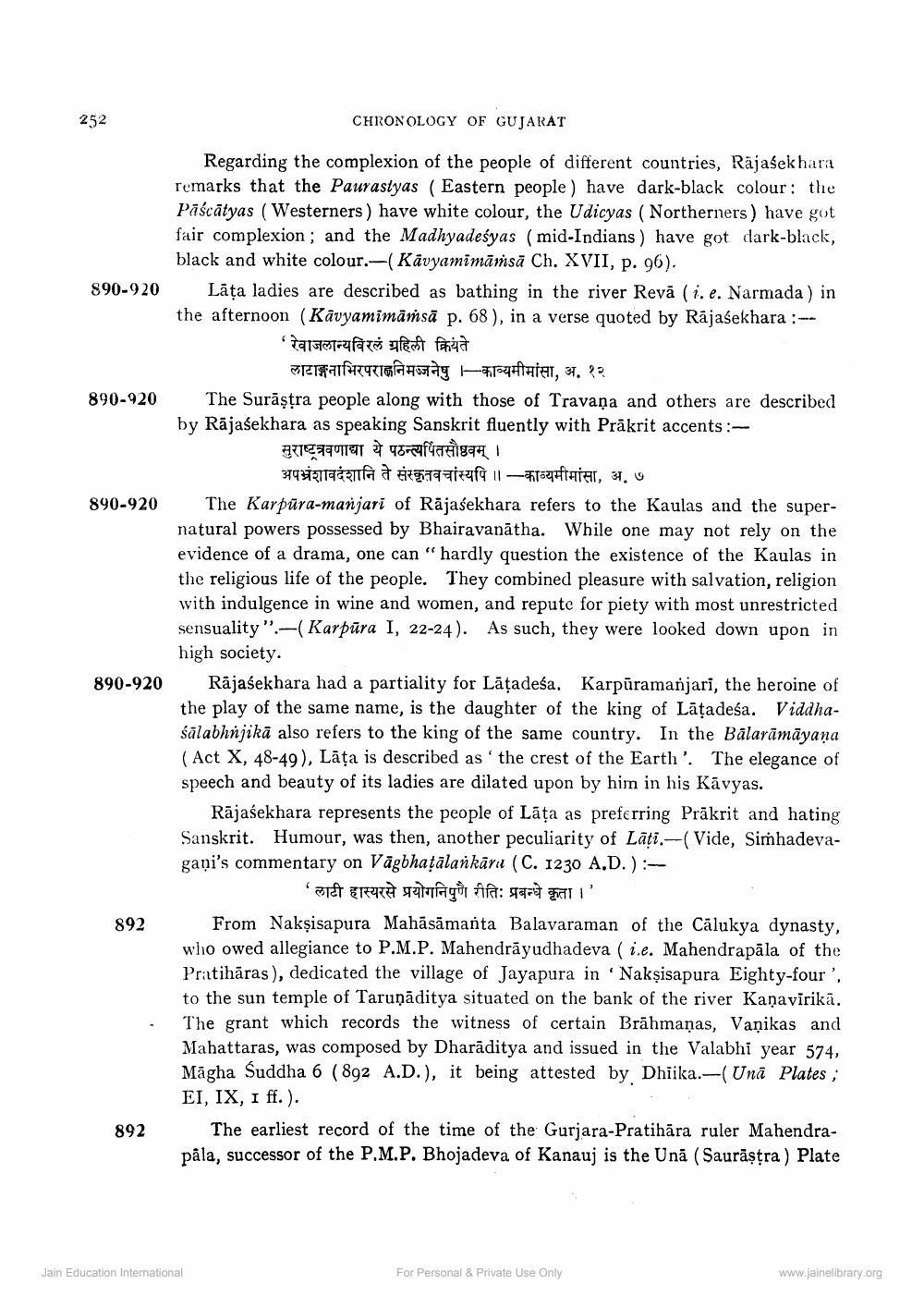________________
252
CHRONOLOGY OF GUJARAT
Regarding the complexion of the people of different countries, Rajasekhara remarks that the Paurastyas (Eastern people ) have dark-black colour: the Pāścātyas (Westerners) have white colour, the Udicyas ( Northerners) have got fair complexion; and the Madhyadeśyas (mid-Indians) have got dark-black,
black and white colour.-(Kavyamimāṁsā Ch. XVII, p. 96). 890-920 Lāța ladies are described as bathing in the river Revā (i.e. Narmada) in the afternoon (Kavyamimāṁsā p. 68), in a verse quoted by Rajasekhara : --
'रेवाजलान्यविरलं ग्रहिली क्रियते
लाटाङ्गनाभिरपराङनिमज्जनेषु । काव्यमीमांसा, अ. १२ 890-920 The Surāştra people along with those of Travana and others are described by Rājasekhara as speaking Sanskrit fluently with Präkrit accents:
सुराष्ट्त्रवणाद्या ये पठन्त्यर्पितसौष्ठवम् ।
अपभ्रंशावदंशानि ते संस्कृतवचांस्यपि ।। -काव्यमीमांसा, अ.७ 890-920 The Karpūra-manjari of Rajasekhara refers to the Kaulas and the super
natural powers possessed by Bhairavanātha. While one may not rely on the evidence of a drama, one can "hardly question the existence of the Kaulas in the religious life of the people. They combined pleasure with salvation, religion with indulgence in wine and women, and repute for piety with most unrestricted sensuality":-( Karpūra I, 22-24). As such, they were looked down upon in
high society. 890-920 Rājasekhara had a partiality for Lāțadeśa. Karpūramanjari, the heroine of
the play of the same name, is the daughter of the king of Lātadeśa. Viddhaśālabhnjikā also refers to the king of the same country. In the Balarāmāyana (Act X, 48-49), Lāța is described as the crest of the Earth'. The elegance of speech and beauty of its ladies are dilated upon by him in his Kāvyas.
Rājasekhara represents the people of Lāța as preferring Prākrit and hating Sanskrit. Humour, was then, another peculiarity of Laţi.-(Vide, Simhadevagani's commentary on Vägbhațălarkānu (C. 1230 A.D.) :
e tra gli afa: qart 1 892 From Nakşisapura Mahāsāmanta Balavaraman of the Cālukya dynasty,
who owed allegiance to P.M.P. Mahendrāyudhadeva ( i.e. Mahendrapāla of the Pratihāras), dedicated the village of Jayapura in Nakşisapura Eighty-four', to the sun temple of Taruņāditya situated on the bank of the river Kaņavirikā. The grant which records the witness of certain Brāhmaṇas, Vanikas and Mahattaras, was composed by Dharāditya and issued in the Valabhi year 574, Māgha Suddha 6 (892 A.D.), it being attested by Dhiika.-(Unā Plates, EI, IX, 1 ff.).
The earliest record of the time of the Gurjara-Pratihāra ruler Mahendrapåla, successor of the P.M.P. Bhojadeva of Kanauj is the Unā (Saurāṣtra) Plate
892
Jain Education International
For Personal & Private Use Only
www.jainelibrary.org




